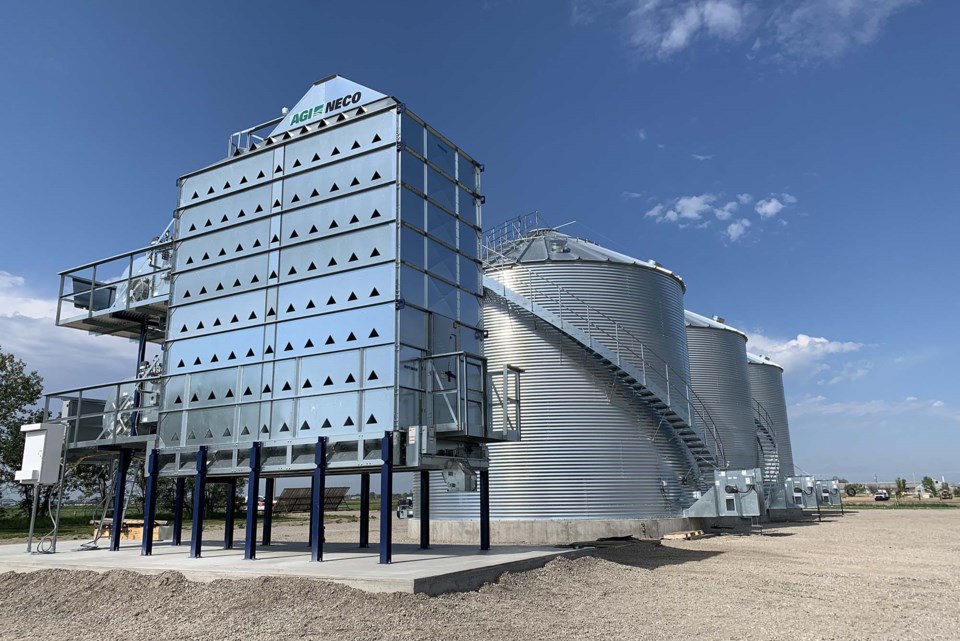How Now Green Cow
How Now Green Cow is examining how farms and food are shaping and being shaped by the climate crisis. Got a food and climate question? Send it to [email protected] so it can be addressed in a future story.
It’s October in Alberta, and that means the end of the harvest season. But around St. Albert, it also often means wet grain that has to be dried before it goes in the silo.
For Bon Accord-area farmer Murray Mulligan, the solution is obvious: he fires up his grain dryer, which is powered by fossil fuels. It’s expensive, but it’s more reliable than leaving his grain to dry in the field.
“Every day you leave grain out there, you get quality losses,” he said, and that means less money in the bank.
Grain drying accounts for about 20 per cent of global greenhouse gas emissions from agriculture, a 2023 study in Sustainable Energy Technologies and Assessments found. Those emissions have got to go if we are to stop global heating, but researchers and farmers are currently stumped as to how.
One hot problem
Grain has to be dried before storage to prevent rot, explained Chandra Singh, a senior research chair in agricultural engineering and technology at Lethbridge Polytechnic. Canada’s short, cold harvest season means farmers often need to dry a whole lot of grain in a very short time, which requires a lot of heat — Mulligan’s dryer cranks out about 12 million BTUs of heat, for example, compared to maybe 75,000 for a home furnace. Most farmers turn to fossil fuels like natural gas to provide that heat, as those fuels are cheap and easy to get.
Those fuels crank out significant amounts of planet-warming pollution. Ontario’s corn harvest alone burns about 300 million litres of propane a year, that province’s agriculture ministry estimates, producing some 450,000 tonnes of CO2 — equivalent to driving about 107,000 cars for a year.
Those fuels also cost money. A 2021 study conducted for four of Alberta’s crop commissions pegged the average cost of grain drying with natural gas in Alberta at about $5.40 per 100 bushels in 2019, rising to $12.60/100 bushels by 2030 due to the carbon tax.
Morinville-area farmer Ron Krywko said he sometimes spends $30,000 a year to dry his grain, or up to 40 cents per bushel. There was so much snow on his farm in 2016 he had to dry his canola twice.
“That really adds up on cost,” he said.
Fuel price fluctuations, the carbon tax, and the environment all give farmers plenty of reasons to ditch fossil fuels when it comes to drying, said William Lubitz, who studies grain drying and energy efficiency at the University of Guelph. Unfortunately, there are few alternatives out there that work at the scale Canadian farmers need.
Solar dryers (which use the sun to heat air in pipes then blow it over grain) exist and are highly efficient, but need plenty of sun to work, the crop commission's study found. Lubitz said an electric heat pump dryer could work, but no one has built a commercially viable one yet.
Biofuel-burning grain dryers exist, but so far have typically been used on small farms with small volumes of grain, Singh said. These dryers also compete with other uses for straw, such as feeding cows.
“There’s no technology yet that would be a viable alternatives to fossil fuels,” Singh said.
Other solutions
But there’s plenty farmers can do to make their current grain dryers more efficient, Singh continued. For example, Singh’s research suggests farmers can trim 25 per cent off their fuel use by switching to a two-step drying process, one where they partially dry grain in their dryers and then dump it into another bin with a fan running to finish it off. The crop commissions study found that rooftop exhaust fans, optimized burners, and indirect-fired dryers can also reduce fuel use. Heat recovery systems can also save energy, but can also cause fires if you’re not diligent in cleaning them, Lubitz said.
The crop commissions study recommended expanding Alberta’s natural gas network so more farmers could use it to dry grain, as natural gas produced 17 to 30 per cent fewer greenhouse gas emissions than propane or diesel. It also recommended exempting fuel used to dry grain from the carbon tax, as there was currently no alternative to it, and instead providing incentives to improve dryer efficiency. (A bill to exempt grain drying from the carbon tax is now being debated in Parliament.)
Singh and Lubitz said governments need to speed up investment into new dryer technologies such as heat pumps to bring them to market.
Reducing greenhouse gas emissions from grain drying will come down to cost, Krywko said.
“Farmers are going to do whatever’s the cheapest,” he said, and if a green alternative costs more, they won’t use it.



